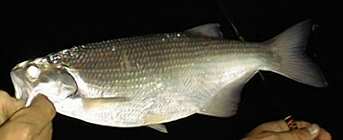Name/Relations || Range/Sizes || Habitat & Habits || Notes
 |
|
| Looks like a herring or shiner but has teeth on tongue and jaws (larger specimens can cause injury ) |
Common Name:
Goldeye
Other Common Names:
River Jack, herring, toothed herring, shiner, shad
Scientific name:Hiodon
alosoides
Family:
Hiodontidae (Mooneyes)
Related Species:
Mooneye, Herrings (very distantly)
| Range: Mississippi River system and tributaries; valley and drainages of the Mississippi River; most of Canada from Alberta to the Northwest Territories to Quebec. |
Sizes: To 3.5lbs maximum, common 1/4lb to 1lb
Habitat: Rivers, Lakes, and Reservoirs, Sloughs of Rivers (as long as they have flow), especially around rocky banks, pilings, and rocks near sand flats. Prefers cooler water from 50 - 65 degrees F but can tolerate large swings in turbidity, temperature, and current.
Spawning Habits:
Feeding Habits:Smaller goldeyes feed primarily on planktonic shrimps, mollusks, and insect larvae. Larger goldeyes eat insects and larvae (especially crickets, mayflies, and caddis), shrimps, worms, and small minnows. Goldeye hunt in schools and packs (multi-sized schools), prowling grass lined rock banks for wind blown insects, and following silverside and shad schools. They will also lurk behind pilings and bridge supports in areas of moderate current, waiting for a drifting meal or disoriented minnow.
Notes:
A very under rated, challenging, ultralight target, the goldeye can provide
action for both the fly angler, bait fisher, and lure tosser. They
take small streamers, woolly worms, and a variety of nymphs and dry flies.
They will also take very small plugs, jigs, spinners, and worms in white/silver
and from 1/2"-2" in size. They have a special fondness for free lined
live crickets and grass hoppers, but will also take small worms and small
minnows (baby shad, shiners, and chubs). They fight hard when hooked,
leap repeatedly, and taste good if smoked (though a little bony).
This fish is an important forage for many larger fishes such as sturgeon,
catfish, drums, bass, and trout (a notoriously important cut bait for large
blue catfish). Take care when handling large goldeyes or you may
discover their sharp teeth the hard way!